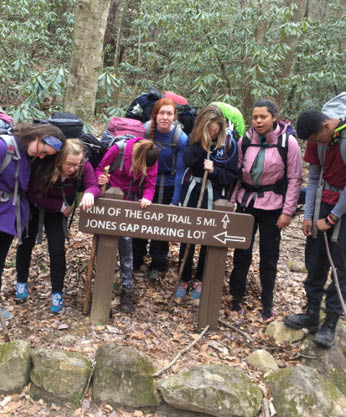How to prepare for a backpacking trip
On Thursday, PESH 172, a class on rafting, camping and backpacking, took a three day trip into Jones Gap state park. They spent their first day white water rafting on the Chattooga River, then spent two days camping and backpacking through Jones Gap in part of the Mountain Bridge Wilderness Area. In the classes prior to the trip, the students learned the basics of how to prepare for a backpacking trip including what to pack, how to pack it, and what to do when they get to camp.
The first and most important thing before any trip is to plan. A hiker should never go unprepared into the woods. PESH 172 is a class that stressed pre-planning as essential to any trip into the wilderness. Each person on the trip must know their part, because each person must depend on the others.
Hikers should know the weather patterns of the area, have a plan for where they will be hiking, outline the times they expect to start and finish hiking and prepare meals and snacks. Weather in the mountains tends to change quickly, so a good rule of thumb is to always be prepared for cold or wet weather.
A hiker should never take what they do not need. It is good to have an extra pair of shoes, but five pairs of running shoes are not needed to do the job. Snacks and meals should be placed into plastic bags rather than bringing cans. In the end, any extra weight will add up.
Additionally, a hiker should never bring an item into the woods that has not been tested. To make the trip run as smoothly as possible, a person should be confident in the equipment and gear they are taking with them.
Lastly, in terms of clothing, cotton is a no-go. For base layers, synthetic, dri-fit material is best. This will wick away sweat and reduce friction, keeping the hiker cool and comfortable. For insulation layers, synthetic or wool material is best. These will hold in body heat better than cotton will.
One of the main concerns for beginner hikers and backpackers is how to pack their supplies. The first thing that a person should put into their bag is an unscented trash bag. This will ensure that, if it rains, their gear will be protected.
Overall, the main points of reference when packing a backpack are balance and accessibility. In terms of balance, it is best to keep the heaviest items in the bottom of the backpack, closest to the back, and the lightest things towards the top. A person should also balance their pack from left to right. If a person puts all of their water to the right of their pack, the weight will be unequally distributed and can throw a person off balance.
In terms of accessibility, items that will not be needed until camp should be placed at the bottom of the pack (i.e. sleeping pad, sleeping bag, camp stove) while items that may be needed quickly (i.e. snacks, pocket knife, headlamp) should be placed at the top of the pack, such as in the topmost pocket of the backpack.
When a hiker gets to camp, the main question is where to set up their tent. To answer this, three main points of reference should be used. The first is to look for flat, even ground. The second is to ask: if it rains, where would the water go? The last point of reference is to look up! If there are any branches in trees that look like they may fall, it is best to place the tent away from these areas.
At night, a hiker should be ready to pack their items that have a scent (i.e. food, sunscreen, hand sanitizer) away from where animals can reach them, such as a bear bag.
Lastly, one of the most important rules to remember while in the woods is the leave no trace policy. Hikers do not own the woods, and there is no maid to pick up after them. After meals, dropped or leftover food should be picked up and put into a trash bag which is taken along with the hiker. For a person to go to the bathroom, wash out meal utensils, or brush their teeth, they should walk at least 75 paces away from any water stream or camp so as not to attract animals. Any trash that is dropped should be picked up and taken with the hiker to be disposed of properly after the trip.
Overall, the three most important elements for any beginner backpacker are these: plan ahead, pack smart, and leave no trace.




